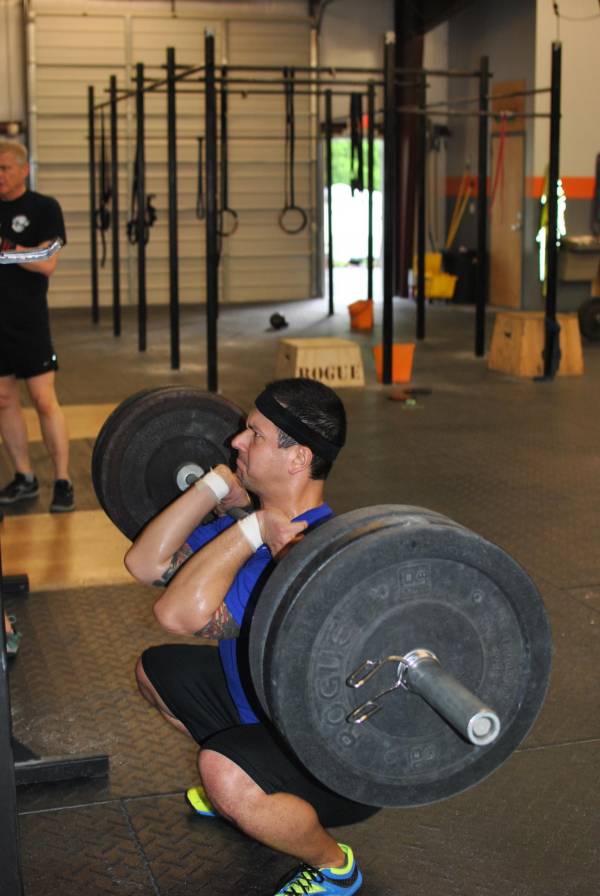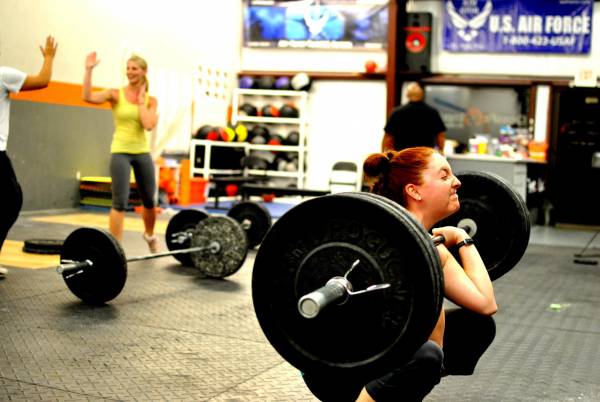This article will be aimed at those lifters who at least on occasion employ the full-squat style of cleaning. Of course almost all competitive Olympic weightlifters use this style, as it is the way to lift the most amount of weight to the shoulders. But many CrossFit and athletes training for other sports skip over this method in favor of the power clean.
Focusing on the power clean is fine, since many sports do not have the need for such added complexity. While more weight can be lifted, squat cleaning is overkill for those who only want to train the extension of the body with as much force as possible. However some people do like to add this technique-heavy style to their lifting repertoire. They may want to develop the added coordination, or perhaps also take some pride in mastering the athletic skill necessary with this full squat style.
I will not go into a full description of the squat clean here. I am assuming you have some knowledge of the general technique. What I will not assume is knowledge of the finer points of the lift that may not be known to those of you outside of competitive weightlifting. While more trainers are now aware of the Olympic lifts, not all have had access to the more esoteric aspects of the lift. What I do want to discuss is one of the tricks of the trade used by elite competitive lifters that might be of use to those of you cleaning substantial weights in the squat style. This technique is what is called catching the bounce.
In a squat clean you pull the bar to roughly waist high, then you jump underneath the rising barbell, while at the same time turning your shoulders over to rack it. With that the bar is safely in the rack position on your shoulders. You then have the task of rising from this low front squat position. If you have more leg strength than what you can pull, then you can simply squat out of the hole with little thought to technique. That is ideal – if you have the legs. Other athletes, usually younger ones, can pull much more than they can front squat. The problem is obvious and so is its solving. You will just have to hit the squat rack.
In between these extremes you find other athletes who can pull only a little bit more to their shoulders than they can rise out of a front squat with. What can they do? If they have a competition scheduled for next week they need something that will help them right now. There is not time to get stronger in the legs. If this is the scenario, then there is room for the athlete to rely on catching the bounce to rise out of that squat to a fully erect position.
What exactly happens when you catch the bounce on your clean? It turns out there are several things you must depend upon in order to pull this off:
#1: Your Quads
 Firstly, as you hit the bottom of your squat, your quadriceps muscles should be under eccentric stretch. They should not be relaxed. When you then begin your rise out of the squat that tension can be used to climb out of the hole to complete the clean. To do this, the quads are quickly flexed concentrically so you get that little bit of extra kick out of the hole.
Firstly, as you hit the bottom of your squat, your quadriceps muscles should be under eccentric stretch. They should not be relaxed. When you then begin your rise out of the squat that tension can be used to climb out of the hole to complete the clean. To do this, the quads are quickly flexed concentrically so you get that little bit of extra kick out of the hole.
#2: Your Calves
Secondly, you get a little assistance out of the simple fleshiness of the backs of the thighs rebounding against the calves. This of course works in conjunction with the previous stretch reflex. These muscles are soft tissue but are held under tension, so when they meet they can bounce off of one another adding a little wee bit of extra force at the bottom. This works better on those with more muscular legs.
#3: Your Bar
Thirdly, when the weight gets heavy there is a third and perhaps most important technique – the flexibility or springiness of the barbell itself. Olympic bars will bend downwards considerably when upward force is placed on them. They will also un-bend upwards to a normal straight state when that force is relieved. In the right circumstances the bar will bend and un-bend several times with each cycle, having less bend each iteration until the bar returns to its homeostatic position. Competition-use Olympic bars are quite springy, more so than powerlifting bars or the standard “Made in China specials” found in many gyms.
Different Olympic bars display varying degrees of springiness. Each make is different and within each make the high-end bars will have more spring to them than the lower end training bars. Because of that, elite lifters have to take into consideration the make of the bar when planning lifts in a meet.
In addition to their native springiness, the displayed bend of any bar will be in direct proportion to the amount of weight on its end sleeves. Each make acts a little differently at different weights, so a lifter has to be aware of this factor, as well.
 If you are smart you will learn how to utilize the energy available in a springy bar as it hits the rack position at the bottom of the clean. With the sudden stop at the bottom of the clean the ends of a springy bar will keep right on bending a certain amount depending on how much weight is on the bar. Then just as the bar hits its lowest position, you start your rise out of the squat, using the other two techniques mentioned. Just as you’re putting this quadriceps force on the bar the barbell ends will un-bend, moving upwards. When this occurs, the barbell is exerting slightly less downward force against gravity than it did when it was fully bent at the very bottom of the clean. That works to your favor.
If you are smart you will learn how to utilize the energy available in a springy bar as it hits the rack position at the bottom of the clean. With the sudden stop at the bottom of the clean the ends of a springy bar will keep right on bending a certain amount depending on how much weight is on the bar. Then just as the bar hits its lowest position, you start your rise out of the squat, using the other two techniques mentioned. Just as you’re putting this quadriceps force on the bar the barbell ends will un-bend, moving upwards. When this occurs, the barbell is exerting slightly less downward force against gravity than it did when it was fully bent at the very bottom of the clean. That works to your favor.
It is during this split-second that you can rise up the necessary several inches, enough to make the difference in a heavy clean. Hopefully you will be far enough out of the low position that you need not worry about the second bend of the bar that will inevitably occur soon after. It may bend and un-bend all the way to the top, in fact. But as you are rising from the squat, you are getting into an ever more favorable position as you climb upward. Once your knees are past the 100° mark or so, you should be able to complete the clean.
Learn to catch the bounce, but do your squats as well. Then squat cleans will not be a problem to complete, and remember, you still have the jerk to do!
Next Week – Catching the Bounce, Part 2: The Jerk
Photos courtesy of CrossFit Impulse.






